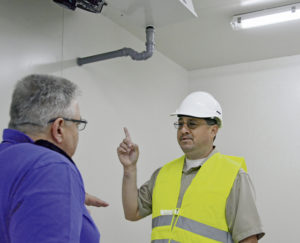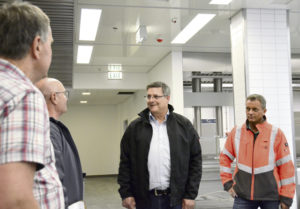
Doing “less with less” affects every Installation Management Command garrison, and U.S. Army Garrison Rheinland-Pfalz is no exception.
As such, the garrison’s Directorate of Public Works has adapted to perform its primary function of maintaining installation infrastructure with reduced funding and fewer resources while staying committed to customer needs by doing its “best with less.”
Doing their best with less first begins with customers knowing how DPW services are categorized, said Gregory Williams, DPW Senior Facility Engineer since October 2016.
Headquarters IMCOM standardizes delivery of services at all garrisons using a Common Level of Support capabilities ranking system, and there are three directed levels of capability under CLS:
Capability Level 1 — Highest (Green)
CL 2 — Mid-range (Amber)
CL 3 — Lowest level (Red)
If DPW goes below CL3, it’s an immediate mission failure, and recently because of funding constraints, most DPW services are resourced at CL3, which means it is at the lowest level of service it can provide without causing mission failure for tenant organizations, Williams explained.
“Each fiscal year, HQ IMCOM provides us with our directed capabilities for performing CLS services. For fiscal 2017, DPW has the lead for 19 CLS services and within those services, they are broken down into Service Support Programs or SSPs. We have the lead for 55 SSPs,” he said. “Within those 55, eight were resourced to perform at the directed CL1, eight are resourced to perform at the directed CL2 and 39 are resourced to perform at CL3 — that means 70 percent of our SSPs are resourced to perform at the lowest level, above mission failure.”
DPW’s mission is to operate and maintain the garrison real property in a manner that does not endanger life, health and safety. Looking at the DPW budget, if it were to perform all of services at CL1, it would cost approximately $204.8 million annually. DPW is projected to receive approximately $127.1 million from HQ IMCOM, allowing it to operate primarily at CL3.
“From the start we are operating in a deficit, and this is one of the reasons we cannot complete all of the service orders and work orders that we have in the system — it’s a matter of funding,” said Williams, a native of Hampton, Va., with 30 years of facilities management expertise. “We are funded to take care of life, health and safety, and the other things we have to look at on a case-by-case basis.”
In a perfect world, DPW would be funded to perform all its service and work orders at CL1, but because of fiscal constraints it isn’t possible, he explained.
“We communicate [our constraints] at the highest levels. We brief this at the Installation Planning Board. We brief this at the Real Property Planning Board, but typically we only have the leadership around the table when we do those briefings, and we don’t have the frontline people or customers there to hear this message first-hand,” Williams said.
Understanding the difference between service and work orders and how each is funded also helps customers know what to expect when it comes to repairs.
A service order or a Demand Maintenance Order is used for minor maintenance and repair. There are three priorities of DMOs:
Priority 1 is an Emergency DMO — that needs to be resolved immediately because it impacts life, health or safety (i.e. — power or water outages). DPW must fix or remediate 100 percent of Priority 1 service orders within 24 hours.
DPW is funded to resolve 50-75 percent of Priority 2 and 3 DMOs; within seven days for Priority 2 and 30 days for Priority 3, subject to the availability of funds.
Work orders or Individual Job Orders are for minor maintenance and repairs above the service-order level, which is determined by cost (above 2,000 Euro) or if it requires more than 40 man hours of repair.
“Typically, HQ IMCOM funds us for our DMO mission at the beginning of the fiscal year, and then we have to compete for IJO funding throughout the year. One major factor in competing for IJO funding is the Installation’s Status Rating for the buildings,” Williams said. “Specifically, the Installation Status Report for Infrastructure or ISR-I rating.”
There are two types of ratings that primarily contribute to the DPW receiving additional funding that include Building Quality Rating (Q) and Building Mission Rating (F). Both of these ratings have four categories ranging from one to four, with one being the highest, he explained.
“The importance of these ratings is that the ratings are initiated by the building occupants. So the building occupants do ISR-I facility condition inspections of their building. Those inspection reports are provided to the DPW staff and the DPW staff loads this into the ISR web based database and it computes an ISR Q or F rating. These facility condition ratings are used as screening criteria when HQ IMCOM prioritizes funding for us to accomplish our IJO mission. The key point there is oftentimes we have units that want work done to their buildings, but their Q and F Ratings don’t support our request for money to do work on the buildings. We struggle to ask Higher Headquarters to give us money to spend on Q1/Q2 and F1/F2.
Quality rating of Q1 indicates the facility condition meets or exceeds Army standards for most or all rated components. The cost to improve is no more than 10 percent of the replacement value.
Q2-rated facilities are similar but the cost to improve will be no more than 20 percent of the replacement value.
Q3-rated facilities are such where the condition fails to meet the minimum level of Army standards for at least one major rated component. The cost to improve is no more than 40 percent of the replacement value.
And finally, a Q4 facility fails to meet the minimum level of Army standards for multiple rated components, but the cost to improve exceeds 40 percent of the replacement value.
Similarly, F-ratings, or mission ratings, assess how well a facility meets the tenant’s needs. They range from F1 to F5, with F1 being the best and F5 the worst. Very few facilities are rated F5, which is reserved for unusual cases, such as a facility left completely inoperable following a natural disaster.
F1 mission-rated facility indicates negligible or no impact on the capability to support the tenant organizations’ required missions. The bay doors are the proper size for the vehicles being maintained in the facility, for example.
F2 indicates moderate deficiencies that have limited impact on the capability to support the tenant organizations’ required missions. All essential/critical functional elements exist.
F3-rated facilities have significant deficiencies that impair the capability to support some of the tenant organizations’ required missions. Some essential/critical functional elements may be missing.
F4 facilites have major facility deficiencies that present considerable obstacles to the tenant organizations’ required mission.
“It’s important that units have someone reliable to do the ISR inspections,” Williams said. “In DPW, we actually train the ISR-I inspectors so they can properly perform the inspections, and at the end of the day, we hope to have the ISR-I ratings that support our requests for funding to do some of the major maintenance and repairs that the buildings require.”
To help DPW with management of general purpose administrative facility DMOs and IJOs, the garrison commander approved a task order to have tenant units appoint a facility manager or a “FacMan” for each building who would act as a liaison between the DPW and the building occupants. Currently, of the 201 general purpose administrative facilities, only eight have designated facility managers, so more building occupants need to volunteer to make this program beneficial.
“I think the FacMan will be a win-win program, because the building occupants will have one person to funnel their DMO and IJO concerns to and that facility manager will work with the DPW staff, and the Installation Site Coordinator/Manager to resolve lingering facility issues,” Williams explained. “We offer an eight-hour facility manager training and finished our first training session May 12.”
During FacMan training, facility managers receive an overview of the DPW process, DMO process, IJO process, ISR-I program, environmental and energy programs, and emphasize the importance of the Interactive Customer Evaluation as a communication tool for them to give us feedback.
“ICE is an opportunity for our customers to give feedback on how we’re doing,” he continued. “Whether it’s good, bad or indifferent — we want the feedback. We’ve got 15 service providers that fall under the heading of public works in ICE. If people don’t know which category to choose, we’ve created a heading called ‘Administration Public Works Office’ and that is a straight connection to the director of DPW and me. It’s the first on the Public Works Office ICE page. I review all of the DPW comment cards. We average about 600 per month. I engage on the dissatisfied ones and give out the satisfied customer comments to supervisors of those employees. I want people to use ICE for the betterment of our organization.”

However, when submitting that ICE comment, it helps if the customer has an understanding of the financial constraints DPW is currently operating within, the levels of support and priorities, and the programs available to assist their mission as they do their best with less.
“In today’s fiscal environment of reduced budgets, this is the reality we face across our command,” added Col. Keith E. Igyarto, garrison commander. “It’s not an excuse. It’s about refocusing our efforts and doing everything we can to continue to provide the seamless, quality service that our customers depend on and that our garrison team takes pride in accomplishing. We routinely reassess our response to work orders and critically look for innovative new approaches to help us meet and exceed customer expectations. Those ideas can be external, as well as internal, so we welcome all feedback from those we are here to serve.”
The Interactive Customer Evaluation site can be accessed at http://ice.disa.mil.


